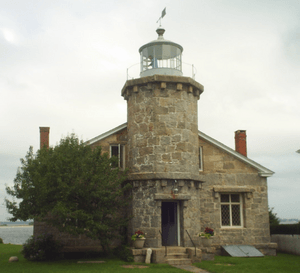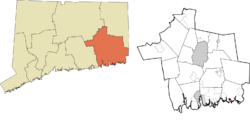Stonington (borough), Connecticut facts for kids
Quick facts for kids
Stonington
|
||
|---|---|---|
| Borough of Stonington | ||

|
||
|
||
| Etymology: Same name as the town it's located in | ||
| Nickname(s):
The Borough
|
||
 New London County and Connecticut New London County and Connecticut |
||
| Country | ||
| state | ||
| County | New London | |
| Region | Southeastern CT | |
| Town | Stonington | |
| Area | ||
| • Total | 2 km2 (0.7 sq mi) | |
| • Land | 0.8 km2 (0.3 sq mi) | |
| • Water | 0.8 km2 (0.3 sq mi) | |
| Population
(2020)
|
||
| • Total | 976 | |
| • Density | 540/km2 (1,390/sq mi) | |
| Time zone | UTC-5 (Eastern (EST)) | |
| • Summer (DST) | UTC-4 (EDT) | |
| ZIP Code |
06378
|
|
| Area code(s) | 860 | |
| FIPS code | 09-73700 | |
| GNIS feature ID | 2378292 | |
Stonington is a small, historic town center in Stonington, Connecticut, USA. People who live there often call it "The Borough." In 2020, about 976 people lived here.
The Borough of Stonington is built on a piece of land that sticks out into Little Narragansett Bay. It has two main streets connecting Cannon Square and Wadawanuck Square. Stonington is known for its beautiful old buildings from colonial times. It has kept its historic charm because there isn't much traffic or modern industry. It's also a popular spot for summer visitors. Stonington is still an active place with one of Connecticut's last fishing and lobstering fleets. Many people of Portuguese heritage live here.
Contents
History of Stonington
Stonington has a rich history, especially during early American wars.
Battles and Bravery
On August 30, 1775, during the American Revolutionary War, a small British ship chased two American boats into Stonington Harbor. The American boats reached the dock and their passengers got off. The British ship then fired its cannons at the dock and nearby buildings. It sailed away but soon returned with two more British ships. All three ships fired at the town all day. The local militia (citizen soldiers) fought back. They believed they hit several British soldiers on the ships.
A bigger attack happened during the War of 1812, from August 9 to 12, 1814. Four British ships, led by Sir Thomas Hardy, 1st Baronet, arrived. The British demanded that Stonington surrender right away. But the brave citizens of Stonington refused. They sent a message saying, "We shall defend the place to the last extremity." This meant they would fight until the very end.
The British Navy attacked the town for three days. But only one elderly woman, who was already very sick, died. The British ships left on August 12, having suffered many dead and wounded soldiers.
A famous poem by Philip Freneau describes this battle:
The bombardiers with bomb and ball
Soon made a farmer's barrack fall,
And did a cow-house badly maul
That stood a mile from Stonington.
They kill'd a goose, they kill'd a hen
Three hogs they wounded in a pen—
They dashed away and pray what then?
This was not taking Stonington.
But some assert, on certain grounds,
(Beside the damage and the wounds),
It cost the king ten thousand pounds
To have a dash at Stonington.
Lighthouse and Fishing
The Stonington Harbor Light is a stone lighthouse built in 1840. In 1925, it became a museum run by the Stonington Historical Society. This makes it the oldest lighthouse museum in America!
Throughout the 1800s, Stonington had a small fleet of boats for fishing, whaling, and sealing. They also traded directly with places like the West Indies. This trade was important enough that Stonington became a "port of entry" in 1842. This meant it was an official place where goods could enter the country. The small granite Customs House, where taxes on goods were collected, still stands today.
Today, Stonington is proud to have the last commercial fishing fleet in Connecticut. This means fishing is still a big part of the town's life.
Geography
Stonington is a small borough. According to the United States Census Bureau, it covers about 0.7 square miles (1.8 square kilometers). Most of this area is water, about 0.3 square miles (0.9 square kilometers). The land area is also about 0.3 square miles (0.9 square kilometers).
Population Information
| Historical population | |||
|---|---|---|---|
| Census | Pop. | %± | |
| 1900 | 2,278 | — | |
| 1910 | 2,083 | −8.6% | |
| 1920 | 2,100 | 0.8% | |
| 1930 | 2,006 | −4.5% | |
| 1940 | 1,826 | −9.0% | |
| 1950 | 1,739 | −4.8% | |
| 1960 | 1,622 | −6.7% | |
| 1970 | 1,413 | −12.9% | |
| 1980 | 1,228 | −13.1% | |
| 1990 | 1,100 | −10.4% | |
| 2000 | 1,032 | −6.2% | |
| 2010 | 929 | −10.0% | |
| 2020 | 976 | 5.1% | |
| U.S. Decennial Census | |||
In 2000, there were 1,032 people living in Stonington. About 97% of the people were White. A small number were Black, Native American, Asian, or Pacific Islander. About 1% of the population was Hispanic or Latino.
The average age of people in Stonington in 2000 was 48 years old. About 13% of the population was under 18. About 22% were 65 years or older.
Education
Children living in Stonington attend schools in the Stonington School District. This district serves the entire town of Stonington.
Images for kids
See also
 In Spanish: Stonington (condado de New London, Connecticut) para niños
In Spanish: Stonington (condado de New London, Connecticut) para niños












